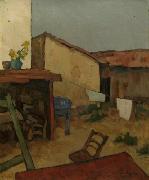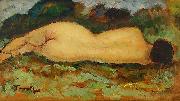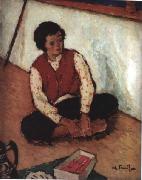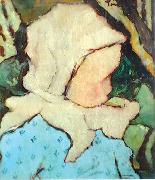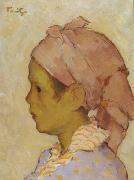
|
Nicolae Tonitza
|
|||
|
|
|||
| (Romanian pronunciation: [nikoˈla.e toˈnit͡sa]; April 13, 1886 - February 27, 1940) was a Romanian painter, engraver, lithographer, journalist and art critic. Drawing inspiration from Post-impressionism and Expressionism, he had a major role in introducing modernist guidelines to local art. Born in Bârlad, he left his home town in 1902 in order to attend the Iaşi National School of Fine Arts, where he had among his teachers Gheorghe Popovici and Emanoil Bardasare.The following year he visited Italy together with University of Bucharest students of archeology under the direction of Grigore Tocilescu.During that period, together with some of his fellow students, Tonitza painted the walls of Grozeşti church. In 1908 he left for Munich, where he attended the Royal Academy of Fine Arts; he began publishing political cartoons in Furnica, and contributing art criticism articles to Arta Română. Tonitza spent the following three years in Paris, where he visited artists' studios, and studied famous paintings.Although the young artist's creation would initially conform to the prevalent style, his gift for colour and his personal touch would eventually lead him towards experiment.Throughout his life, he remained committed to the Munich School, hailing its innovative style over the supposedly "obscure imitators of Matisse". | |||
|
|
|||
|
Nicolae Tonitza new24/Nicolae Tonitza-745635.jpg Pintura Identificación:: 76595 |
Curte la Mangalia, ulei pe carton, semnat dreapta jos, 62x50 cm. cyf | ||
|
|
|||
|
Nicolae Tonitza
|
|||
|
|
|||
| (Romanian pronunciation: [nikoˈla.e toˈnit͡sa]; April 13, 1886 - February 27, 1940) was a Romanian painter, engraver, lithographer, journalist and art critic. Drawing inspiration from Post-impressionism and Expressionism, he had a major role in introducing modernist guidelines to local art. Born in Bârlad, he left his home town in 1902 in order to attend the Iaşi National School of Fine Arts, where he had among his teachers Gheorghe Popovici and Emanoil Bardasare.The following year he visited Italy together with University of Bucharest students of archeology under the direction of Grigore Tocilescu.During that period, together with some of his fellow students, Tonitza painted the walls of Grozeşti church. In 1908 he left for Munich, where he attended the Royal Academy of Fine Arts; he began publishing political cartoons in Furnica, and contributing art criticism articles to Arta Română. Tonitza spent the following three years in Paris, where he visited artists' studios, and studied famous paintings.Although the young artist's creation would initially conform to the prevalent style, his gift for colour and his personal touch would eventually lead him towards experiment.Throughout his life, he remained committed to the Munich School, hailing its innovative style over the supposedly "obscure imitators of Matisse". | |||
|
|
|||
|
Nicolae Tonitza new24/Nicolae Tonitza-543865.jpg Pintura Identificación:: 77954 |
Nud întins, ulei pe carton subțire, 20x34 cm, semnat stânga jos, cu brun, Tonitza. cyf | ||
|
|
|||
|
Nicolae Tonitza
|
|||
|
|
|||
| (Romanian pronunciation: [nikoˈla.e toˈnit͡sa]; April 13, 1886 - February 27, 1940) was a Romanian painter, engraver, lithographer, journalist and art critic. Drawing inspiration from Post-impressionism and Expressionism, he had a major role in introducing modernist guidelines to local art. Born in Bârlad, he left his home town in 1902 in order to attend the Iaşi National School of Fine Arts, where he had among his teachers Gheorghe Popovici and Emanoil Bardasare.The following year he visited Italy together with University of Bucharest students of archeology under the direction of Grigore Tocilescu.During that period, together with some of his fellow students, Tonitza painted the walls of Grozeşti church. In 1908 he left for Munich, where he attended the Royal Academy of Fine Arts; he began publishing political cartoons in Furnica, and contributing art criticism articles to Arta Română. Tonitza spent the following three years in Paris, where he visited artists' studios, and studied famous paintings.Although the young artist's creation would initially conform to the prevalent style, his gift for colour and his personal touch would eventually lead him towards experiment.Throughout his life, he remained committed to the Munich School, hailing its innovative style over the supposedly "obscure imitators of Matisse". | |||
|
|
|||
|
Nicolae Tonitza new24/Nicolae Tonitza-658694.jpg Pintura Identificación:: 82063 |
Date 1923-1925 cyf | ||
|
|
|||
|
Nicolae Tonitza
|
|||
|
|
|||
| (Romanian pronunciation: [nikoˈla.e toˈnit͡sa]; April 13, 1886 - February 27, 1940) was a Romanian painter, engraver, lithographer, journalist and art critic. Drawing inspiration from Post-impressionism and Expressionism, he had a major role in introducing modernist guidelines to local art. Born in Bârlad, he left his home town in 1902 in order to attend the Iaşi National School of Fine Arts, where he had among his teachers Gheorghe Popovici and Emanoil Bardasare.The following year he visited Italy together with University of Bucharest students of archeology under the direction of Grigore Tocilescu.During that period, together with some of his fellow students, Tonitza painted the walls of Grozeşti church. In 1908 he left for Munich, where he attended the Royal Academy of Fine Arts; he began publishing political cartoons in Furnica, and contributing art criticism articles to Arta Română. Tonitza spent the following three years in Paris, where he visited artists' studios, and studied famous paintings.Although the young artist's creation would initially conform to the prevalent style, his gift for colour and his personal touch would eventually lead him towards experiment.Throughout his life, he remained committed to the Munich School, hailing its innovative style over the supposedly "obscure imitators of Matisse". | |||
|
|
|||
|
Nicolae Tonitza new25/Nicolae Tonitza-676543.jpg Pintura Identificación:: 87661 |
Fetiţa cu fular. Date n/a cyf | ||
|
|
|||
|
Nicolae Tonitza
|
|||
|
|
|||
| (Romanian pronunciation: [nikoˈla.e toˈnit͡sa]; April 13, 1886 - February 27, 1940) was a Romanian painter, engraver, lithographer, journalist and art critic. Drawing inspiration from Post-impressionism and Expressionism, he had a major role in introducing modernist guidelines to local art. Born in Bârlad, he left his home town in 1902 in order to attend the Iaşi National School of Fine Arts, where he had among his teachers Gheorghe Popovici and Emanoil Bardasare.The following year he visited Italy together with University of Bucharest students of archeology under the direction of Grigore Tocilescu.During that period, together with some of his fellow students, Tonitza painted the walls of Grozeşti church. In 1908 he left for Munich, where he attended the Royal Academy of Fine Arts; he began publishing political cartoons in Furnica, and contributing art criticism articles to Arta Română. Tonitza spent the following three years in Paris, where he visited artists' studios, and studied famous paintings.Although the young artist's creation would initially conform to the prevalent style, his gift for colour and his personal touch would eventually lead him towards experiment.Throughout his life, he remained committed to the Munich School, hailing its innovative style over the supposedly "obscure imitators of Matisse". | |||
|
|
|||
|
Nicolae Tonitza new26/Nicolae Tonitza-699874.jpg Pintura Identificación:: 97258 |
Nicolae Tonitza (1886 - 1940) - Micuţa tătăroaică. cyf | ||
|
|
|||
|
Also Buy::. For Following Paintings / Artists / Products, Please Use Our Search Online: |





